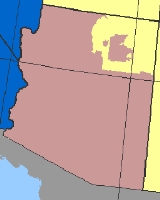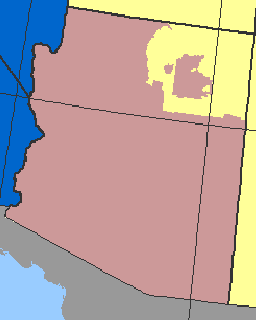
Uniform Time Act
Encyclopedia
The Uniform Time Act of 1966, , was a United States federal law to "promote the adoption and observance of uniform time within the standard time zones" prescribed by the Standard Time Act
of 1918. Its intended effect was to simplify the official pattern of where and when daylight saving time
(DST) is applied within the U.S. Prior to this law, each state
worked out its own scheme for the dates of beginning and ending DST, and in some cases, which parts of the state should use it.
The law as originally written required states that observe DST to begin it at 02:00 local time on the last Sunday in April and to end it at 02:00 local time on the last Sunday in October and explicitly preempted all state laws related to daylight saving time per the weights and measures power given to Congress in Article 1, Section 8 of the U.S. Constitution. The law was later amended in 1986 to move the uniform start date for DST to the first Sunday in April (effective 1987). The latest amendment, part of the Energy Policy Act of 2005
, extends DST by four or five weeks by moving the uniform start date for DST to the second Sunday in March and the end date to the first Sunday in November (effective 2007). However, the Department of Energy
is required to report to Congress the impact of the DST extension by December 1, 2007 (nine months after the statute took effect) which the department has not done and the report is now overdue. If the DST extension failed to save energy, Congress
may revert back to the old schedule set in 1986.
The law does not require that all states observe DST. Individual states may exempt themselves from DST and observe standard time year-round by passing a state law, provided:
While there are a few areas where de facto
differences within states exist, the overall pattern is simple enough, and close enough to actual practice, that it is effective and efficient
 The most notable de facto exception is that Arizona
The most notable de facto exception is that Arizona
has chosen not to use DST statewide. However, the various Native American
nations within the state have the right to use DST, or not use it, as they see fit. The Navajo Nation
has chosen to use DST throughout its territory, which includes parts of Arizona, New Mexico
, and Utah
. If it did not, then the Navajo Nation would lack a uniform time during the Summer months. On the other hand, the Hopi
Nation, whose territory is surrounded by that of the Navajo Nation, and is entirely within the boundaries of the State of Arizona, has chosen not to use DST.
Standard Time Act
The Standard Time Act, , also known as the Calder Act, was the first United States federal law implementing standard time and Daylight saving time in the United States. It authorized the Interstate Commerce Commission to define each time zone....
of 1918. Its intended effect was to simplify the official pattern of where and when daylight saving time
Daylight saving time
Daylight saving time —also summer time in several countries including in British English and European official terminology —is the practice of temporarily advancing clocks during the summertime so that afternoons have more daylight and mornings have less...
(DST) is applied within the U.S. Prior to this law, each state
U.S. state
A U.S. state is any one of the 50 federated states of the United States of America that share sovereignty with the federal government. Because of this shared sovereignty, an American is a citizen both of the federal entity and of his or her state of domicile. Four states use the official title of...
worked out its own scheme for the dates of beginning and ending DST, and in some cases, which parts of the state should use it.
The law as originally written required states that observe DST to begin it at 02:00 local time on the last Sunday in April and to end it at 02:00 local time on the last Sunday in October and explicitly preempted all state laws related to daylight saving time per the weights and measures power given to Congress in Article 1, Section 8 of the U.S. Constitution. The law was later amended in 1986 to move the uniform start date for DST to the first Sunday in April (effective 1987). The latest amendment, part of the Energy Policy Act of 2005
Energy Policy Act of 2005
The Energy Policy Act of 2005 is a bill passed by the United States Congress on July 29, 2005, and signed into law by President George W. Bush on August 8, 2005, at Sandia National Laboratories in Albuquerque, New Mexico...
, extends DST by four or five weeks by moving the uniform start date for DST to the second Sunday in March and the end date to the first Sunday in November (effective 2007). However, the Department of Energy
United States Department of Energy
The United States Department of Energy is a Cabinet-level department of the United States government concerned with the United States' policies regarding energy and safety in handling nuclear material...
is required to report to Congress the impact of the DST extension by December 1, 2007 (nine months after the statute took effect) which the department has not done and the report is now overdue. If the DST extension failed to save energy, Congress
United States Congress
The United States Congress is the bicameral legislature of the federal government of the United States, consisting of the Senate and the House of Representatives. The Congress meets in the United States Capitol in Washington, D.C....
may revert back to the old schedule set in 1986.
The law does not require that all states observe DST. Individual states may exempt themselves from DST and observe standard time year-round by passing a state law, provided:
- if the state lies entirely within a time zoneTime zoneA time zone is a region on Earth that has a uniform standard time for legal, commercial, and social purposes. In order for the same clock time to always correspond to the same portion of the day as the Earth rotates , different places on the Earth need to have different clock times...
, that the exemption apply statewide, or - if the state is divided by a time zone boundary, that the exemption apply statewide or to the entire part of the state on one side of the boundary.
While there are a few areas where de facto
De facto
De facto is a Latin expression that means "concerning fact." In law, it often means "in practice but not necessarily ordained by law" or "in practice or actuality, but not officially established." It is commonly used in contrast to de jure when referring to matters of law, governance, or...
differences within states exist, the overall pattern is simple enough, and close enough to actual practice, that it is effective and efficient
- for repeat travelers, and repeat users of long-distance telephone service, to learn the basic pattern, and
- for those in areas where de facto exceptions apply to mention the fact to those likely to be affected by it.

Arizona
Arizona ; is a state located in the southwestern region of the United States. It is also part of the western United States and the mountain west. The capital and largest city is Phoenix...
has chosen not to use DST statewide. However, the various Native American
Native Americans in the United States
Native Americans in the United States are the indigenous peoples in North America within the boundaries of the present-day continental United States, parts of Alaska, and the island state of Hawaii. They are composed of numerous, distinct tribes, states, and ethnic groups, many of which survive as...
nations within the state have the right to use DST, or not use it, as they see fit. The Navajo Nation
Navajo Nation
The Navajo Nation is a semi-autonomous Native American-governed territory covering , occupying all of northeastern Arizona, the southeastern portion of Utah, and northwestern New Mexico...
has chosen to use DST throughout its territory, which includes parts of Arizona, New Mexico
New Mexico
New Mexico is a state located in the southwest and western regions of the United States. New Mexico is also usually considered one of the Mountain States. With a population density of 16 per square mile, New Mexico is the sixth-most sparsely inhabited U.S...
, and Utah
Utah
Utah is a state in the Western United States. It was the 45th state to join the Union, on January 4, 1896. Approximately 80% of Utah's 2,763,885 people live along the Wasatch Front, centering on Salt Lake City. This leaves vast expanses of the state nearly uninhabited, making the population the...
. If it did not, then the Navajo Nation would lack a uniform time during the Summer months. On the other hand, the Hopi
Hopi
The Hopi are a federally recognized tribe of indigenous Native American people, who primarily live on the Hopi Reservation in northeastern Arizona. The Hopi area according to the 2000 census has a population of 6,946 people. Their Hopi language is one of the 30 of the Uto-Aztecan language...
Nation, whose territory is surrounded by that of the Navajo Nation, and is entirely within the boundaries of the State of Arizona, has chosen not to use DST.

